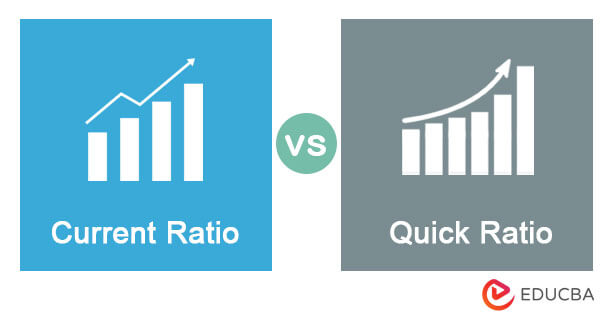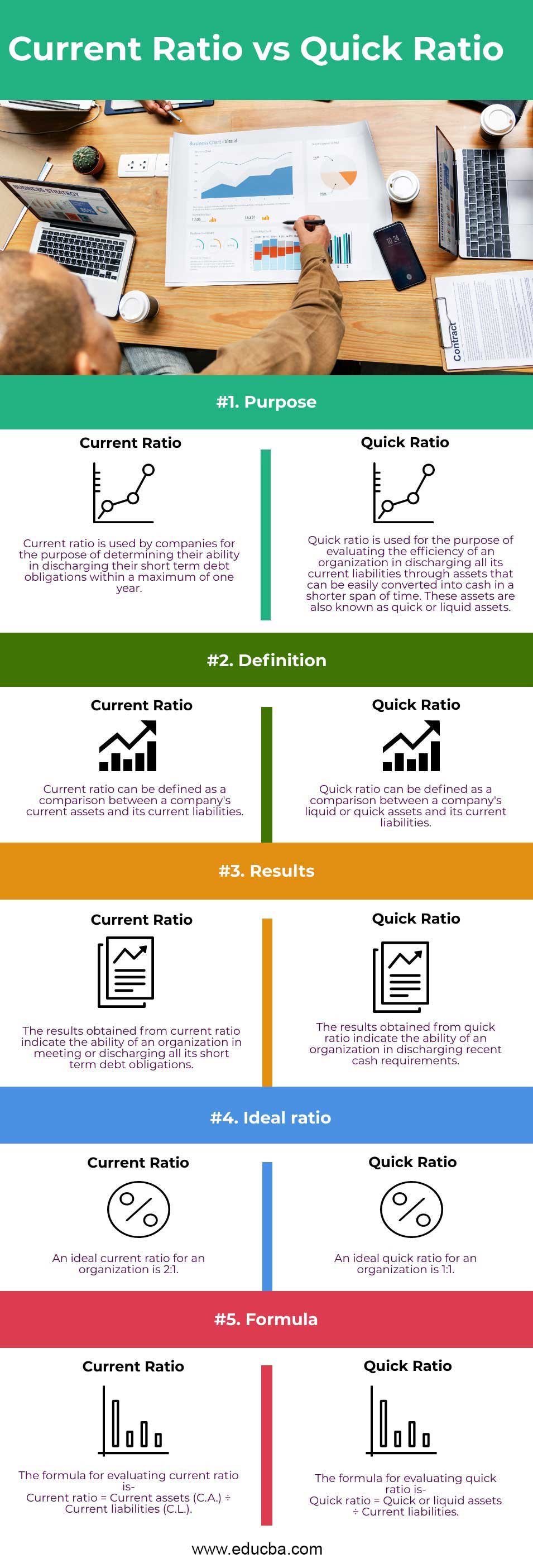Updated July 24, 2023

Difference Between Current Ratio vs Quick Ratio
Current Ratio vs Quick Ratio in this, the current ratio can be defined as a liquidity ratio that is taken into use for measuring the financial ability of an organization in meeting its debt obligations. In other words, the current ratio is an indicator of an organization’s liquidity. The current ratio can also be defined as a comparison between an organization’s current assets and current liabilities. The current ratio of an organization can be evaluated by dividing its current assets by current liabilities. For example, 2:1 is considered as an ideal current ratio, although this may not be the same for all industries. A higher current ratio may denote that an organization cannot use its current assets effectively.
On the other hand, the quick ratio, also known as the acid test ratio, can be defined as a liquidity ratio that is taken into account to measure an organization’s financial ability in utilizing its quick assets or cash to get rid of existing short-term debt obligations. The quick ratio is the comparison between liquid or quick assets and current liabilities. An ideal quick ratio must be 1:1, and an organization whose liquid ratio is below 1 will fail in paying off its current debt obligations. While calculating quick ratios, inventory is not considered, whereas, in the calculation of current ratios, inventory is considered.
Head To Head Comparison Between Current Ratio vs Quick Ratio (Infographics)
Below are the top 5 differences between the Current Ratio vs Quick Ratio:

Key Differences Between Current Ratio vs Quick Ratio
The key differences between the Current Ratio vs Quick Ratio are discussed below:
- The current ratio is used to measure the liquidity as well as the solvency of a company with respect to its ability to discharge all its current debt obligations with the current assets that are available with the same. On the other hand, a quick ratio is used to measure if the company has sufficient quick assets to pay off its short-term debt obligations.
- An ideal current ratio for an organization is 2:1. In the case of banking institutions, 1.33:1 is considered to be an ideal current ratio. The type of liquid assets and liabilities available in an organization and its nature of business are the factors that decide the ideal current ratio for the same. However, a ratio ranging between 1.33 and 3 is considered ideal. On the other hand, 1:1 is an ideal quick ratio.
- The formula for evaluating the current ratio is: Current ratio = Current assets (C.A.) ÷ Current liabilities(C.L.) Here, current assets can be calculated by adding all the Inventories, cash-in-hand, sundry debtors, trade receivables, bank deposits, short-term loans and advances, prepaid investments, disposable investments, and other current assets, whereas current liabilities can be calculated by adding up the creditors, overdraft cash credit, short-term loans, outstanding expenses, unclaimed dividend, proposed dividend, provision for tax, advance from buyers and other current liabilities (C.L.).
Formula
The formula for evaluating quick ratio is:
Here, quick or liquid assets can be determined by using either of the following methods-
Adding up cash-in-hand, bank deposits, short-term investments, trade receivables, and short-term loans and advances.
The formula for Quick assets or liquid assets is:
Finding the difference between current assets (C.A.), inventories, and prepaid expenses (P.E.).
Current liabilities in quick or acid test ratio can be calculated by adding up the cash credit, creditors, overdraft, proposed dividend, outstanding expenses, advance from buyers, short-term loans, unclaimed dividend, provision for tax, and other current liabilities (C.L.).
Comparison Table of Current Ratio vs Quick Ratio
Let’s discuss the topmost comparison between the Current Ratio vs Quick Ratio:
| Basis of Comparison |
Current Ratio |
Quick Ratio |
| Purpose | The current ratio is used by companies for the purpose of determining their ability to discharge their short-term debt obligations within a maximum of one year. | The quick ratio is used for the purpose of evaluating the efficiency of an organization in discharging all its current liabilities through assets that can be easily converted into cash in a shorter span of time. These assets are also known as quick or liquid assets. |
| Definition | The current ratio can be defined as a comparison between a company’s current assets and its current liabilities. | A quick ratio can be defined as a comparison between a company’s liquid or quick assets and its current liabilities. |
| Results | The results obtained from the current ratio indicate the ability of an organization in meeting or discharging all its short-term debt obligations. | The results obtained from a quick ratio indicate the ability of an organization in discharging recent cash requirements. |
| Ideal Ratio | An ideal current ratio for an organization is 2:1. | An ideal quick ratio for an organization is 1:1. |
| Formula | The formula for evaluating the current ratio is-
Current ratio = Current assets (C.A.) / Current liabilities (C.L.). |
The formula for evaluating quick ratio is-
Quick ratio = Quick or liquid assets / Current liabilities |
Conclusion
The current ratio helps in analyzing the capability of an organization in discharging its current financial obligations, whereas the quick ratio helps in analyzing the capability of an organization in tackling its immediate cash requirements. When the current ratio is greater than 1, it means the current liabilities of the company are greater than its current assets, whereas when the current ratio is less than 1, it means that the current assets of the company are greater than its current liabilities.
On the other hand, when the quick ratio of a company is greater than 1, it means that its current liabilities are higher than the liquid or quick assets, and as a result of this, the company might face troubles in discharging its short-term debt obligations. When the quick ratio is less than 1, it means that the liquid assets of a company are higher than its current liabilities, and as a result of this, the company can easily pay off all its short-term debt obligations.
Recommended Articles
This is a guide to the Current Ratio vs Quick Ratio. Here we discuss the Current Ratio vs Quick Ratio key differences with infographics and a comparison table. You can also go through our other suggested articles to learn more –

